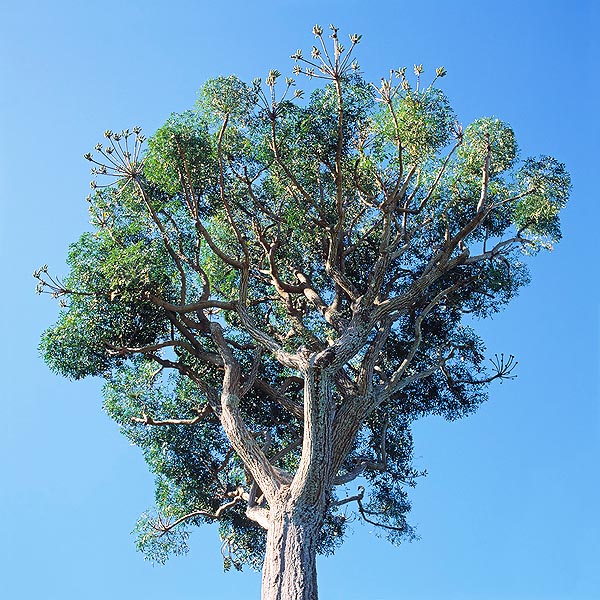Family : Araliaceae

Text © Pietro Puccio

English translation by Mario Beltramini

Very decorative tree, can be 15 m tall, and a remedy against malaria © Giuseppe Mazza
The genus is honoured to the French botanist Pierre Cusson (1727-1783); the name of the species comes from the Latin “spicatus” = which holds spikes, with reference to its inflorescences.
Common names: “cabbage-tree”, “common cabbage tree”, “lowveld cabbage”, “tree spiked cabbage tree” (English); “kiepersol” (Afrikaans); “cussonia en épis” (French); “arbol de la col” (Spanish); “Kohlbaum” (German).
Evergreen or semi-deciduous tree, much ramified in the aged specimen, with greyish bark in the young branches, yellowish and deeply fissured in the old ones, tall up to about 15 m, with the foliage concentrated in thick globes at the apex of the branches.
The leaves, which have a diameter of about 70 cm, are dark green or bluish green, on petioles long up to 60 cm, and are palmate-compound with 5-9 lobes long up to 30-35 cm, irregularly pinnate and deeply carved by the mid nervation, with 6-15 cm long and 4 cm broad leaflets, with the margins usually indented; when young, the leaves can be more or less entire. The inflorescences are terminal panicles, with greenish-yellow flowers assembled in 8-12 compact spikes, long up to 20 cm, with the shape of a candelabrum. The fruits are ovoid, purple when ripe, and with a diameter of about 6 mm.
It reproduces by seed, which has a short lasting germination time, in which case it will blossom starting from the eighth year of age, and by cutting. Fast growing plant, very ornamental due to the shape of its crown and of its leaves, suitable for tropical, subtropical and, marginally, warm temperate climate, as it bear temperatures as low as -3/-4°C for short time, to be planted isolated in order to exalt its characteristics, and in any case, away from walls, enclosures, sewer pipes, etc., as it has a very aggressive and superficial radical apparatus. In pot, it is cultivated in sandy and draining substrata, in luminous location and temperatures never less than 12-14°C; watering must be moderate during the vegetative period and reduced in winter. Due to the stem which can assume contorted forms, and the succulent roots, it is an appreciated subject for the collectors of caudiciform plants and for realizing bonsai.
The plant is an important source of food for the local fauna and the leaves are also utilized for cattle foraging; the succulent roots are edible and utilized in emergency situations, and parts of the plant are employed in the traditional medicine, in particular the bark decoction, when treating malaria, and the leaves in case of indigestion.
Synonyms: Cussonia quercifolia Colla (1824); Cussonia triptera Colla (1824); Cussonia calophylla Miq. (1844); Cussonia kraussii Hochst. (1844); Cussonia boivinii Drake (1897).
→ To appreciate the biodiversity within the ARALIACEAE family please click here.
